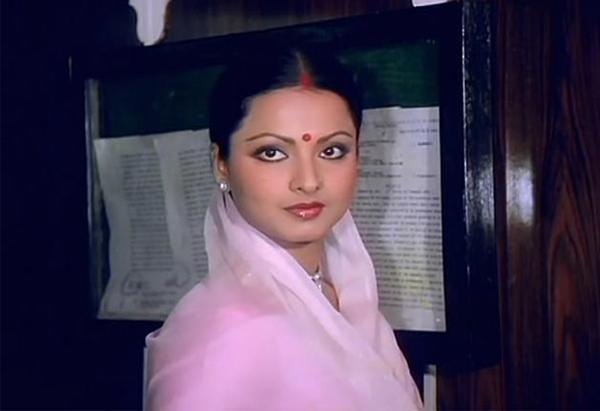 nil
nil
Is bindi a fashion statement?
Is the bindi a fashion statement, a caste mark or a marriage symbol? It is all three. Placed within contemporary perspectives, it is debatable whether it is popular television that has resurrected the bindi as a cosmetic to enhance the feminine image of woman. Shoma A. Chatterji examines
History shows that men of royalty, priestly families and high caste men in India sported a mark at the centre of their foreheads as a mandatory cultural custom. Even today, children in many Hindu families wear a dot of curd on the forehead as an auspicious sign before a job interview or an exam for good luck. In a Bengali marriage, the foreheads of both the bride and the groom are marked with a decorative bindi drawn out of sandalwood paste (chandan) to signify the auspicious event.
But traditionally it is the woman who is associated with the bindi to set her apart as a Hindu married woman though it has also been used as a facial adornment and a caste mark for men in some regions.
Also loosely known as 'tika', 'pottu', 'sindoor', 'tilak', 'tilakam', ‘teep’, ‘kumkum', a bindi was originally a small or a big, eye-catching round dot. In Maharashtra, Gujarat, the Punjab and some southern states, girls choose to wear a bindi, while in Uttar Pradesh, Bihar, Orissa, West Bengal and Assam, it is a mandatory practice of the married woman to adorn a red bindi, though unmarried girls can also wear it. The same applies to married women in Nepal..jpg)
Bindis in different colours to match the clothes came later. There was a phase when ‘not wearing a bindi’ was considered an assertive fashion statement by women but it did not last long.
A lot of it has to do with the popularity of television serials, giving it a new identity as a fashion statement. The journey began with Shanti on Doordarshan where the young and naïve Mandira Bedi in the title role, attracted everyone with her strikingly original bindi, an arrow in reverse instead of the normal red dot. This was followed by Neena Gupta’s mega-serial Saans where the title logo was a red bindi underlined with a black line, a metaphor for the commitment of a modern wife and mother to her family.
Ekta Kapoor’s serials brought about the radical metamorphosis of the bindi. Sudha Chandran, who made the zig-zag parting of her hair in her Kahin Kissi Roz a fashion statement, said, “My bindis were more memorable than my performance in the serial.” The round red bindi is reserved for the sati savitri housewives in saas-bahu serials, while all kinds of squiggles, triangles, question marks, often in black, decorated with sequins and stars, depict thefemme fatale.
Crooner Usha Uthup uses the first consonant of the Bengali alphabet “kaw” like a bindi as an expression of her love for Kolkata. Ingenuous jewellery designers hit upon the bejeweled bindi in precious and semi-precious stones. Today bindis decorated with stars and sequins are quite popular for festivals and parties. Youngsters now wear these bindis in different parts of their bodies in place of tattoos.
Hindi mainstream cinema thrived on the bindi as signifier of many things between 1959 and mid-70s. But there is an old film too that uses Kunku (bindi) as the title of the Marathi film. Directed by V. Shantaram, Kunku (1937) was about Nirmala, a young orphan, married to a widower old enough to be her father. The director placed repeated stress on Nirmala's half-afraid and half-defiant act of putting on kumkum every morning. Her rebellion is a conscious one, a tragic irony on her sham of a marriage. Her act of looking at herself in the mirror repeatedly stresses her introspection and her fear of her uncertain and dark future. Till the end, she refuses conjugal rights to her husband who, from a sense of deep guilt, commits suicide.
On the other hand, the blurred bindi suggested rape of the protagonist Radha in Mother India. It stood for loss of virginity upon marriage in umpteen films while wiping it out when a suhaagan becomes a widow was also an oft-repeated metaphor. In Basu Bhattacharya’s Anubhav (1971), the blurred bindi suggests reunion between a couple after a phase of misunderstanding.
.jpg) The big screen lost its love affair with the bindi since Meena Kumari’s big red bindi in a hundred different films followed by Hema Malini and Rekha. The bindi faded out with the entry of stars like Sridevi, Karisma Kapoor, Madhuri Dixit and Priyanka Chopra sporting foreheads stripped of the bindi. Bindiya chamkegi remains one of the most memorable songs framed around the bindi from the hit film Do Raaste (1969).
The big screen lost its love affair with the bindi since Meena Kumari’s big red bindi in a hundred different films followed by Hema Malini and Rekha. The bindi faded out with the entry of stars like Sridevi, Karisma Kapoor, Madhuri Dixit and Priyanka Chopra sporting foreheads stripped of the bindi. Bindiya chamkegi remains one of the most memorable songs framed around the bindi from the hit film Do Raaste (1969).
Make-up artist Rajesh Patil blames the westernised look of Hindi mainstream cinema’s female characters today for the fading out of the bindi from mainstream cinema. Sanjay Leela Bhansali brought it back in Devdas andParineeta took it up later but both these are ‘period’ films.
Today, heroines in Bollywood films on or off screen do not wear the bindi either as a fashion statement or as a sign of marriage because sartorial choices have changed over the years. But television still holds the bindi as almost a mandatory cosmetic for the married woman.
Asha Hariharan who runs a beauty salon in Mumbai, echoes this stating that. the bindi represents liberation. Young girls who happily wear the bindi now often worn as a tattoo, temporary or permanent, with their sweatshirts and jeans defy the ‘unwritten’ code that the bindi/tatoo goes only with Indian attire. Women in the West go gaga over the bindi and many of them sport it with their western attire.
The bindi today signifies different things to different people. For women in this part of the globe and even Europe, it is now a fashion statement and a symbol of changing culture in a globalised world.
Top Headlines
-
Entertainment
Valentyn Vasyanovychs To The Victory! wins 2025 TIFF Platform Award unanimously
September 26, 2025
-
Entertainment
Chlo Zhaos Hamnet Wins TIFF 2025 Peoples Choice Award
September 20, 2025
-
Entertainment
Sholay: Golden even after fifty years
July 04, 2025
-
Entertainment
War 2: Check out Hrithik Roshan, Jr NTR and Kiara Advani's new posters
June 26, 2025
-
Entertainment
LGBTQIA+: Icelandic film Odd Fish and Brazil's Baby win big at KASHISH 2025 film festival
June 12, 2025
-
Entertainment
Katrina Kaif named Maldives tourism global brand ambassador ahead of Modi's visit
June 10, 2025
-
Entertainment
'Queen marches to conquer': Deepika Padukone joins Atlee's AA22xA6 starring Allu Arjun after 'Spirit' exit
June 08, 2025
-
Entertainment
Dakota Johnson and Chris Martin, who were in on-and-off relationship, broke up: Reports
June 06, 2025
-
Entertainment
Sharmila Tagore to Alia Bhatt, India weaves cross-generational tale at Cannes 2025
May 28, 2025
-
Entertainment
Is Sandeep Reddy Vanga's cryptic 'feminism' post meant for Deepika Padukone? Neitzens think so
May 27, 2025


